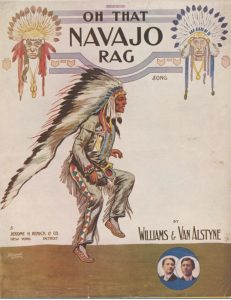Born in Marengo, IL, pianist and composer Egbert Van Alstyne (1882-1951) was an accomplished musician whose musical endeavors appeared on Broadway and in vaudeville. In 1903, he got his big break from a piece he composed entitled “Navajo”, which musically demonstrates racist stereotypes of Indigenous peoples perpetuated by white Americans. He and lyricist Harry Williams later composed “Oh, that Navajo Rag”, a ragtime piece with text which further pigeonholes and generalizes the Navajo tribe. Unfortunately, Van Alstyne’s work is one of innumerable examples of how music perpetuated and upheld racist stereotypes in the United States. Van Alstyne’s work, among many other composers and artists, raises significant questions about the portrayal of Native Americans throughout history, and how these portrayals might have impacted us all.
Unfortunately, Van Alstyne and Williams’ bigoted repertoire is robust. Many more of their compositions are centered around prejudiced views towards Native Americans, such as “Cheyenne” and “San Antonio”. And many other composers were publishing similar works at approximately the same time. For instance, Don Bestor’s “That Indian Rag”, Edward Coleman’s “My Indian Maiden”, and Theodore Morse’s “Wise Old Indian” were all published around the same time as Van Alstyne and William’s works. What is especially alarming is the popularization of Van Alstyne and Williams music. “Navajo” was later included in Marie Cahill’s Broadway musical Nancy Brown, and “Oh, that Navajo Rag” was recorded and performed in 1911 by Billy Murray, one of the most famous vaudeville singers of his time. The creation of this work might be considered by some to be disappointing but unsurprising; but what is certainly appalling is that audiences were listening and applauding.
When studying American music, it is important to be acutely and consistently critical of those artists and creatives who helped to lay the foundations of the American cultural framework we live in today. While we frequently critique musicologists in this course for their malpractices and wrongdoings, perhaps we ought to consider the sins of the artist as more significant. Our artistic ancestors in some way influence the art we make and thus the world we live in today. The effects of their art is long lasting, and it is difficult to write off these artistic pieces as a product of their time when their impacts are felt today.
Billy Murray. Oh, that Navajo Rag. Victor Records. 1911. Library of Congress, https://www.loc.gov/item/jukebox-130930/.
Bestor, Don. That Indian Rag. Will Rossiter, 1910.
Coleman, Edward. My Indian Maiden. The American Advance Music Co, 1904.
Ewen, David. Popular American Composers. New York, The H. W. Wilson Company, 1962.
Levy, Lester S. “Growing Pains.” Give me Yesterday: American History in Song 1890-1920, University of Oklahoma Press, 1975, 169-195.
Morse, Theodore F. Wise Old Indian. Theodore Morse Music Co, 1909.
“Murray, Billy.” Grove Music Online, 3 Sept. 2014, https://doi.org/10.1093/gmo/9781561592630.article.A2267265.
Van Alstyne, Egbert. Navajo: Indian Characteristique March and Two Step. Shapiro, Bernstein & Co, 1903.
Van Alstyne, Egbert. Oh, that Navajo Rag. Jerome H. Remick & Co, 1911. Accessed from: https://webapp1.dlib.indiana.edu/metsnav/inharmony/navigate.do?oid=http://fedora.dlib.indiana.edu/fedora/get/iudl:469351/METADATA&pn=1&size=screen.
“Van Alstyne, Egbert (Anson).” The Grove Dictionary of American Music. 2nd ed. 2013.

